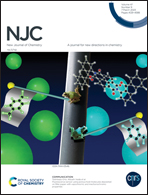Sulfonamides linked to sulfonate esters via hydrazone functionality: synthesis, human carbonic anhydrase inhibitory activities, and molecular modeling studies†
Abstract
In the present study, we synthesized novel carbonic anhydrase (CA, EC 4.2.1.1) inhibitors by linking various sulfonate esters to a benzenesulfonamide fragment via hydrazone functionality (SH1–SH14). Following structural characterization using spectral techniques, the obtained molecules were screened for their inhibitory potential against tumor-associated human (h) isoforms hCA IX and XII, along with the physiologically dominant isoforms hCA I and II. Introducing methyl, methoxy or chlorine substituents into the para position of the terminal phenyl ring led to the most effective hCA IX and/or hCA XII inhibitors, with Ki values < 10 nM. Drug-likeness and pharmacokinetic profiles of the selected compounds were predicted using in silico techniques. Finally, molecular docking studies of the most effective inhibitor, 4-((2-(4-sulfamoylbenzoyl)hydrazono)methyl)phenyl 4-methoxybenzenesulfonate (SH3), against the tumor-associated hCA isoforms IX (Ki = 9.4 nM) and XII (Ki = 5.9 nM) were carried out to rationalize the inhibition data.



 Please wait while we load your content...
Please wait while we load your content...